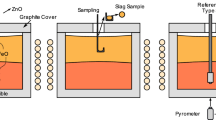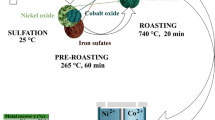Conclusions
-
1.
Thermodynamic calculations show that the interactions of most of the minerals considered in this review with sulfuric acid, should result in a significant heat release, which in the first instance is related to the oxidation of the sulfides.
-
2.
The lower the Me/S ratio in the sulfide, the greater the heat effect from the oxidation of 1 g of sulfide. At the same time, calculations of the equivalent unit show that for certain exceptions (covellite) the value of ΔQ (kcal/g·at·S) is approximately constant at 215±17 kcal.
-
3.
The main component of the heat effect in the reaction of waste slag with sulfuric acid is determined (from experimental results) by the reaction of the nickel-containing minerals; with refractory copper minerals, primarily by the oxidation of the iron-containing sulfides (faster than pyrrhotite) and partly by the oxidation of the nickel-containing components. Sulfides of copper in this case are virtually undissolved.
-
4.
On the previous assumptions, the provisional temperature effect of the process, based on the experimental data, can raise the temperature of slag and copper ores up to 100°C and 480°C respectively.
Similar content being viewed by others
Literature Cited
P. I. Mel'nikov, O. P. Ivanov, and V. N. Makarov, “Influence of cryogenic migration of chemical elements and its signficance in prospecting formations in regions of long term frost,” in: Dokl. Akad. Nauk SSSR,303, No. 4 (1988).
L. F. Narkelyun and A. I. Trubachev, in: Oxidation of Ores of Udokan [in Russian], Nauka, Novosibirsk (1987).
V. M. Pitul'ko, in: Secondary Aureoles of Dissemination in Cryolithozone [in Russian], Nedra, Leningrad (1977).
I. A. Tyutyunov, in: Processes of Change and Transformation of Soils and Rocks at Negative Temperatures [in Russian], Izd. Akad. Nauk. SSSR, Moscow (1963).
I. A. Tyutyunov, “Physicochemical changes in rocks of the Far North,” in: Physical Chemistry of Processes in Freezong and Frozen Rocks [in Russian], Izd. Akad. Nauk SSSR, Moscow (1961).
S. L. Shvartsev, “Physicochemical processes in layer of long term frozen rock,” in: Cryogenic Processes in Soils and Rocks, [in Russian], Nauka, Moscow (1965).
G. A. Yurgenson, and Yu. P. Bezrodnykh. “Zonal oxidation of Udokanskii copper deposits and its role in the formation of temperature field in long term frozen rocks,” in: Geocryological Conditions in the Transbaikal North [in Russian], Nauka, Moscow (1966).
A. A. Saukov, in: Geokhimiya, No. 2, [in Russian], Gosgeolizdat, Moscow (1951).
Basis of Geocryology, [in Russian], Izd. Akad. Nauk SSSR, Moscow (1959).
O. P. Ivanov, “Basic factors in development of zone of oxidation of sulfide deposits under long term frost,” Geokhimiya, No. 9 (1966).
Yu. G. Shastkevich, “Long term frozen rocks of the high mountain range of Udokan and conditions of formation of the temperature field in them,” in: Geocryological Conditions in the Transbaikal North [in Russian], Nauka, Moscow (1966).
M. M. Derbeneva, “Problems of heat effects in physicochemical reactions,” in: Particles of Heat and Mass Transfer in Frozen Rocks [in Russian], Nauka, Moscow (1965).
G. B. Naumov, B. N. Ryzhenko, and I. L. Khodakovskii, Handbook of Thermodynamic Values [in Russian], Atomizdat, Moscow (1971).
T. A. Stolyarova, “Enthalpy of formation of pentlandite,” Dokl. Akad. Nauk SSSR,216, No. 4 (1974).
Handbook—Tables of Physical Values [in Russian], Atomizdat, Moscow (1976).
Additional information
Translated from Fiziko-Tekhnicheskie Problemy Razrabotki Poleznykh Iskopaemykh, No. 3, pp. 90–97, May–June, 1991.
Rights and permissions
About this article
Cite this article
Pantsurkina, T.K. Possible heat effects during chemical decomposition and geotechnological leaching of sulfide ores and intermediate products. Soviet Mining Science 27, 251–257 (1991). https://doi.org/10.1007/BF02500905
Issue Date:
DOI: https://doi.org/10.1007/BF02500905




